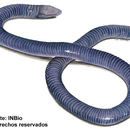Description
provided by AmphibiaWeb articles
Oscaecilia osae is a slender, medium-sized caecilian, with the holotype measuring 382 mm in total length. This species is highly attenuated, especially when compared to the other more robust members of its genus. It has a high count of primary annuli (232), while the secondary annuli are completely absent. Scales are small, ovoid to elliptical in shape, whitish and transparent in appearance, and begin at annulus 175 (thus present in 57 of the 232 annuli). Oscaecilia osae has two indistinct collars and the collar grooves are incomplete ventrally. The vent appears round in the preserved holotype but in life is likely transverse; the vent lacks a disc, and the aperture has 12 lobes. There is an absence of anal glands and the end of the body is somewhat acute with an unsegmented terminal shield (other members of the genus lack terminal shields). The surface of the tongue is textured. The teeth are thick, short, widely-spaced, and slightly recurved. The tentacle is below the naris and just slightly posterior to it, and is not visible in dorsal view. Numerous punctate glands are present, evenly distributed on the body, but more concentrated anteriorly and laterally (Lahanas and Savage 1992).This species also shares the following characteristics with others in the genus Oscaecilia: absent true tail; absent terminal keel; presence of splenial teeth; absent diastema between the palatine and vomerine teeth; vomeropalatine tooth row positioned more posteriorly; presence of narial plugs (tuberculate in O. osae) on the tongue; and eyes positioned underneath bone, rendering them invisible (Lahanas and Savage 1992; Savage and Wake 2001). The coloration appears lavender, but closer inspection (x 60) reveals a darker ground color with many closely-spaced pinkish-cream punctate glands. Anteriorly and laterally, the pinkish-cream markings become closer together and eventually fuse giving rise to the more pinkish appearing head and ventral region. In preserved specimens, the lavender areas appear grayish-brown (Lahanas and Savage 1992).It was the first of its genus to be discovered in Costa Rica (Lahanas and Savage 2002).A Spanish-language species account can be found at the website of Instituto Nacional de Biodiversidad (INBio) (http://darnis.inbio.ac.cr/FMPro?-DB=UBIpub.fp3&-lay=WebAll&-Format=/ubi/detail.html&-Op=bw&id=4327&-Find).
- Bolaños, F., Wake, M. and Wilkinson, M. (2004). Oscaecilia osae. In: IUCN 2007. 2007 IUCN Red List of Threatened Species. www.iucnredlist.org. Downloaded on 16 January 2008.
- Lahanas, P. N., and Savage, J. M. (1992). ''A new species of caecilian from the Peninsula de Osa of Costa Rica.'' Copeia, 1992(3), 703-708.
Distribution and Habitat
provided by AmphibiaWeb articles
Oscaecilia osae has only been located on the Península de Osa in south-western Costa Rica at 3-40 m above sea level (Bolaños et al. 2004). It occurs in tropical lowland wet forest. The holotype was discovered on a rainy night in a flooded grassy airstrip, 2 m from a stream and 3 m from the edge of a forest, at an elevation of 3 m above sea level (Lahanas and Savage 1992).
Life History, Abundance, Activity, and Special Behaviors
provided by AmphibiaWeb articles
Nothing has been published on the life history of this species, but it is likely to be fossorial, as are the other members of the genus.
Life History, Abundance, Activity, and Special Behaviors
provided by AmphibiaWeb articles
There are no known population declines or threats to this species, primarily because of a lack of information. This species, like most caecilians, is considered Data Deficient (IUCN 2006). However, it does occur in a protected area (Parque Nacional Corcovado).
Oscaecilia osae: Brief Summary
provided by wikipedia EN
Oscaecilia osae is a species of caecilian in the family Caeciliidae. It is endemic to Costa Rica and is only known from the Golfo Dulce area, on the Pacific Ocean side of Costa Rica. The specific name osae refers to its type locality, the airstrip at La Sirena, being located on the Osa Peninsula. It is also known as the airstrip caecilia or airstrip caecilian.
- license
- cc-by-sa-3.0
- copyright
- Wikipedia authors and editors

